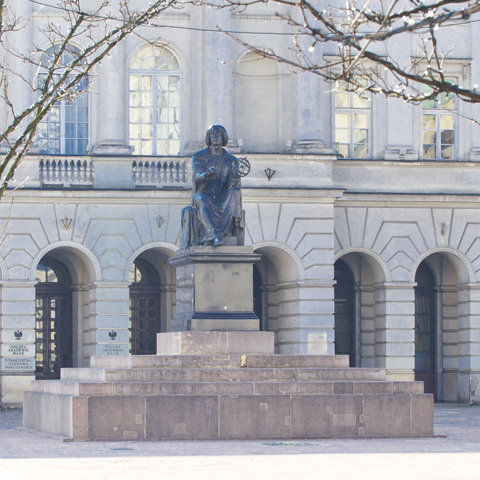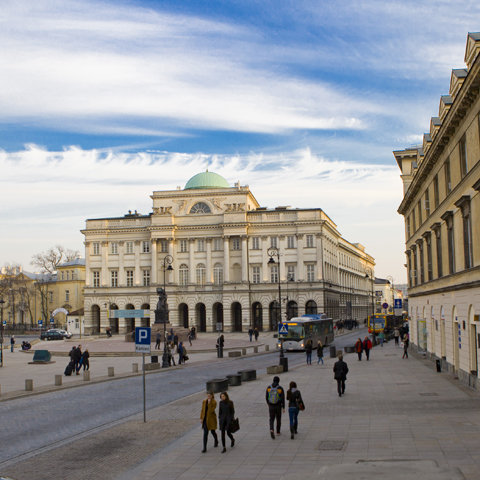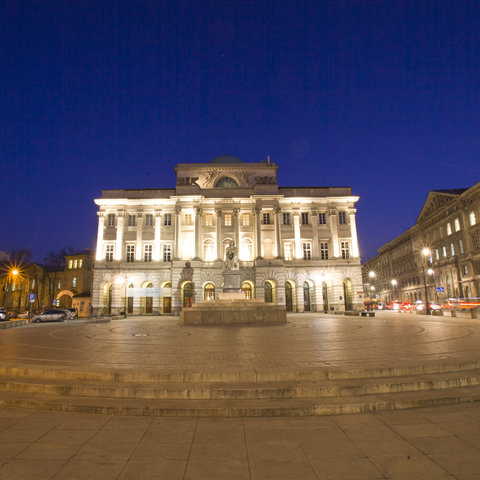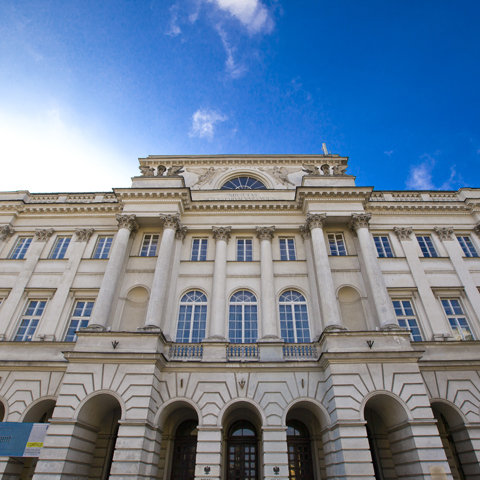Composers / Fryderyk Chopin / Places catalog
Staszic Palace
This magnificent classical edifice, now the main building of the Polish Academy of Sciences, was constructed in 1820–1823 as the headquarters of the Warsaw Society for the Friends of Learning, of which Stanisław Staszic was then president. The palace was designed by Antonio Corazzi and built on the site of a Dominican church and monastery demolished in accordance with a tsarist edict implemented by Viceroy Józef Zajączek. Tsar Alexander I had originally wanted to build an orthodox church in memory of the seventeenth-century burial chapel for the Shuisky tsars that had stood here, but abandoned the plan. Julian Ursyn Niemcewicz maliciously speculated that he did so because it was ‘not spacious enough for him to ride that way by cariole and not spacious enough to deploy regiments’.
The Society purchased the site on the initiative of Staszic in 1818 and held its first meeting there in January 1825.
The following description is from Łukasz Gołębiewski, in a Warsaw guidebook published in 1827: ‘A representation of the native grandeur of the most serene Emperor and King Alexander I, made by Professor [Antoni] Blank, graces the public conference hall. On the opposite side is a portrait of the Saxon king by Bacciarelli. The bas-reliefs on the walls are by Maliński and the stucco and other decorations by Vincenti. The walls are adorned with busts of Potocki, Naruszewicz, Ignacy Krasicki, Jan Kochanowski and Sarbiewski. There is a spacious amphitheatre opposite the place for members. Hundreds of people can be comfortably seated and there are loges with Corinthian columns’.
Society members occupied residential apartments in the building (e.g. Count Fryderyk Skarbek had lodgings there in 1824). There were also rooms and offices full of priceless memorabilia (e.g. the Gen. Jan Henryk Dąbrowski Hall, which housed his bequests) and a library of over 20,000 volumes that was open to people outside the Society (Fryderyk Chopin made use of it during his student days).
On 11 May 1830, a few months before the outbreak of the November Uprising, a statue of Copernicus by the Danish sculptor Bertel Thorvaldsen was unveiled outside the palace. The monument was financed by public contributions (e.g. Mikołaj Chopin contributed) and was generally approved, although the unveiling ceremony did not pass without scandal. The unveiling was meant to be preceded by a service at Holy Cross Church, but the mass was called off, apparently due to opposition from some of the clergy, who still held a grudge against Copernicus (although there are other versions of what happened). After the unveiling, the Society, led by President Julian Ursyn Niemcewicz, gave a ceremonial lunch. Again, this did not go ahead without a hitch, as Niemcewicz had made an inauspicious call to Grand Duke Constantine beforehand. The ruler, apprehensive about Niemcewicz’s patriotic leanings, demanded the contents of the speech he had planned for the dinner, so as to censor it if need be.
-

Mikołaj Kopernik Monument. Phot. Waldemar Kielichowski.
-

Staszic Palace. Phot. Waldemar Kielichowski.
-

Staszic Palace. Phot. Waldemar Kielichowski.
-

Staszic Palace. Phot. Waldemar Kielichowski.
-

Staszic Palace. Phot. Waldemar Kielichowski.